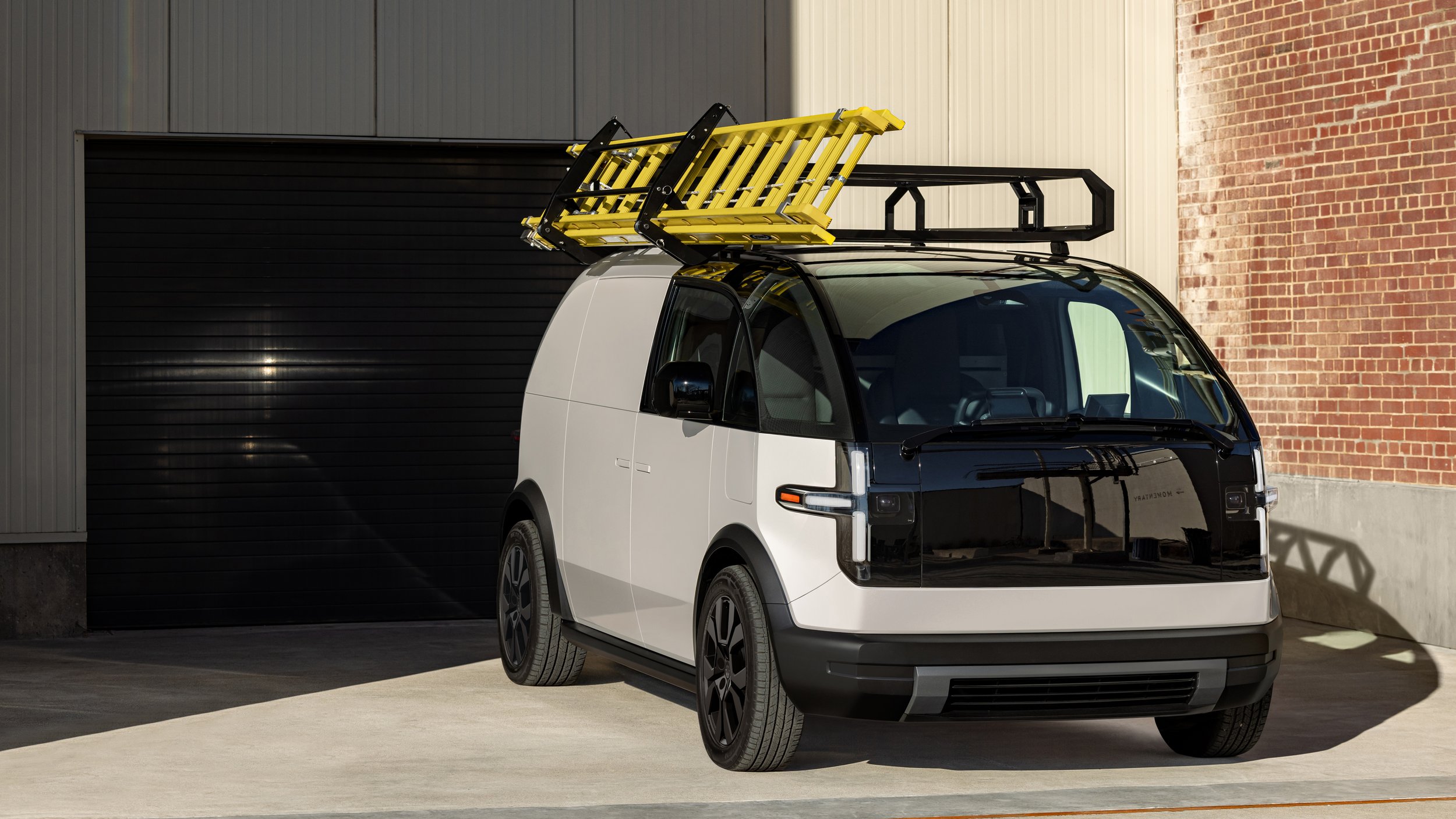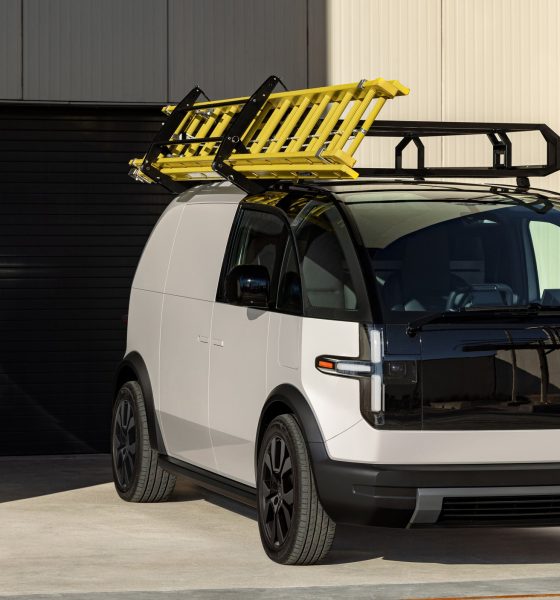Canoo has announced another massive order for their electric vans, with Kingbee ordering nearly 10,000 units.
Canoo has made a 180-degree turn compared to earlier this year when it announced they were nearing bankruptcy. Since then, the company has received thousands of orders, most notably from Walmart, for their Lifestyle Vehicle (LV) and Lifestyle Delivery Vehicle (LDV) vans. Now, the company has added another order for nearly 10,000 vehicles to their list, this time from Kingbee, a work-ready van rental company.
The binding order from Kingbee vans is for 9,300 Canoo vehicles, with the option to increase their order to 18,600 vehicles in the future. Kingbee will be retrofitting the completed vans for construction work and deploying them over the 27 states where they operate. No timeline for introducing these vehicles was included in the press release.
Despite other options, such as the Ford E-Transit, Kingbee CEO Scott Haslam still believes Canoo vans are their best option. “Canoo vehicles are designed specifically for fleets to be upfit and last multiple users. This is exactly what we need. Our assets are our business, and we need products that provide the best driver experience with durability.”
Tony Aquila, Chairman & CEO at Canoo, agreed with the sentiment regarding his product’s fleet design, further claiming that Canoo vans hold the title for “class-leading ROI.”
Canoo commented to Teslarati that their product’s customization is also a feature that has attracted customers. “New and legacy innovators recognize a need for safety, efficiency, and productivity in their fleet portfolio. Our LDV has it all in a fully electric multi-generational platform, with market-pushing customization, that is made to last and outperform expectations.”
Along with this nearly 10,000 vehicle order, Canoo has pre-existing orders from Walmart and Zeeba totaling roughly 10,000 vehicles, leading to the question; where does the brand plan on manufacturing these 20,000 units? Currently, Canoo has two production facilities. One in Northwestern Arkansas and another in Northeastern Oklahoma; however, it is unclear if these facilities are now in production or how many vehicles they have produced.
In a comment to Teslarati, Canoo clarified their production schedule saying, “[we] are finalizing our multi-year allocations for 2023 customer deliveries and will share our manufacturing plan with the broader market shortly.” Also, noting that “we haven’t shared our customer fulfillment schedule yet, but our CEO has shared that we will deliver product for fleet order for Walmart first.”
Canoo has yet to post its Q3 results regarding financials or production numbers, but looking back to Q2 of this year, the company was still struggling with profitability. More worryingly for investors, despite Walmart’s already completed order for vehicles, they had not (at the time) announced that any units had been produced for delivery.
These more recent deals that Canoo has established may be the turnaround that the company desperately needed, but they aren’t out of the woods yet. Investors and consumers alike are looking for the ordered models to be produced. Without further evidence that they are moving towards that objective, they may find themselves in the same situation as earlier this year.
What do you think of the article? Do you have any comments, questions, or concerns? Shoot me an email at william@teslarati.com. You can also reach me on Twitter @WilliamWritin. If you have news tips, email us at tips@teslarati.com!

News
Tesla FSD fleet is nearing 7 billion total miles, including 2.5 billion city miles
As can be seen on Tesla’s official FSD webpage, vehicles equipped with the system have now navigated over 6.99 billion miles.

Tesla’s Full Self-Driving (Supervised) fleet is closing in on almost 7 billion total miles driven, as per data posted by the company on its official FSD webpage.
These figures hint at the massive scale of data fueling Tesla’s rapid FSD improvements, which have been quite notable as of late.
FSD mileage milestones
As can be seen on Tesla’s official FSD webpage, vehicles equipped with the system have now navigated over 6.99 billion miles. Tesla owner and avid FSD tester Whole Mars Catalog also shared a screenshot indicating that from the nearly 7 billion miles traveled by the FSD fleet, more than 2.5 billion miles were driven inside cities.
City miles are particularly valuable for complex urban scenarios like unprotected turns, pedestrian interactions, and traffic lights. This is also the difference-maker for FSD, as only complex solutions, such as Waymo’s self-driving taxis, operate similarly on inner-city streets. And even then, incidents such as the San Francisco blackouts have proven challenging for sensor-rich vehicles like Waymos.
Tesla’s data edge
Tesla has a number of advantages in the autonomous vehicle sector, one of which is the size of its fleet and the number of vehicles training FSD on real-world roads. Tesla’s nearly 7 billion FSD miles then allow the company to roll out updates that make its vehicles behave like they are being driven by experienced drivers, even if they are operating on their own.
So notable are Tesla’s improvements to FSD that NVIDIA Director of Robotics Jim Fan, after experiencing FSD v14, noted that the system is the first AI that passes what he described as a “Physical Turing Test.”
“Despite knowing exactly how robot learning works, I still find it magical watching the steering wheel turn by itself. First it feels surreal, next it becomes routine. Then, like the smartphone, taking it away actively hurts. This is how humanity gets rewired and glued to god-like technologies,” Fan wrote in a post on X.
News
Tesla starts showing how FSD will change lives in Europe
Local officials tested the system on narrow country roads and were impressed by FSD’s smooth, human-like driving, with some calling the service a game-changer for everyday life in areas that are far from urban centers.

Tesla has launched Europe’s first public shuttle service using Full Self-Driving (Supervised) in the rural Eifelkreis Bitburg-Prüm region of Germany, demonstrating how the technology can restore independence and mobility for people who struggle with limited transport options.
Local officials tested the system on narrow country roads and were impressed by FSD’s smooth, human-like driving, with some calling the service a game-changer for everyday life in areas that are far from urban centers.
Officials see real impact on rural residents
Arzfeld Mayor Johannes Kuhl and District Administrator Andreas Kruppert personally tested the Tesla shuttle service. This allowed them to see just how well FSD navigated winding lanes and rural roads confidently. Kruppert said, “Autonomous driving sounds like science fiction to many, but we simply see here that it works totally well in rural regions too.” Kuhl, for his part, also noted that FSD “feels like a very experienced driver.”
The pilot complements the area’s “Citizen Bus” program, which provides on-demand rides for elderly residents who can no longer drive themselves. Tesla Europe shared a video of a demonstration of the service, highlighting how FSD gives people their freedom back, even in places where public transport is not as prevalent.
What the Ministry for Economic Affairs and Transport says
Rhineland-Palatinate’s Minister Daniela Schmitt supported the project, praising the collaboration that made this “first of its kind in Europe” possible. As per the ministry, the rural rollout for the service shows FSD’s potential beyond major cities, and it delivers tangible benefits like grocery runs, doctor visits, and social connections for isolated residents.
“Reliable and flexible mobility is especially vital in rural areas. With the launch of a shuttle service using self-driving vehicles (FSD supervised) by Tesla in the Eifelkreis Bitburg-Prüm, an innovative pilot project is now getting underway that complements local community bus services. It is the first project of its kind in Europe.
“The result is a real gain for rural mobility: greater accessibility, more flexibility and tangible benefits for everyday life. A strong signal for innovation, cooperation and future-oriented mobility beyond urban centers,” the ministry wrote in a LinkedIn post.
News
Tesla China quietly posts Robotaxi-related job listing
Tesla China is currently seeking a Low Voltage Electrical Engineer to work on circuit board design for the company’s autonomous vehicles.

Tesla has posted a new job listing in Shanghai explicitly tied to its Robotaxi program, fueling speculation that the company is preparing to launch its dedicated autonomous ride-hailing service in China.
As noted in the listing, Tesla China is currently seeking a Low Voltage Electrical Engineer to work on circuit board design for the company’s autonomous vehicles.
Robotaxi-specific role
The listing, which was shared on social media platform X by industry watcher @tslaming, suggested that Tesla China is looking to fill the role urgently. The job listing itself specifically mentions that the person hired for the role will be working on the Low Voltage Hardware team, which would design the circuit boards that would serve as the nervous system of the Robotaxi.
Key tasks for the role, as indicated in the job listing, include collaboration with PCB layout, firmware, mechanical, program management, and validation teams, among other responsibilities. The role is based in Shanghai.
China Robotaxi launch
China represents a massive potential market for robotaxis, with its dense urban centers and supportive policies in select cities. Tesla has limited permission to roll out FSD in the country, though despite this, its vehicles have been hailed as among the best in the market when it comes to autonomous features. So far, at least, it appears that China supports Tesla’s FSD and Robotaxi rollout.
This was hinted at in November, when Tesla brought the Cybercab to the 8th China International Import Expo (CIIE) in Shanghai, marking the first time that the autonomous two-seater was brought to the Asia-Pacific region. The vehicle, despite not having a release date in China, received a significant amount of interest among the event’s attendees.










